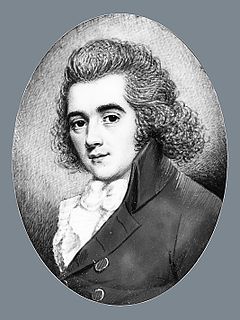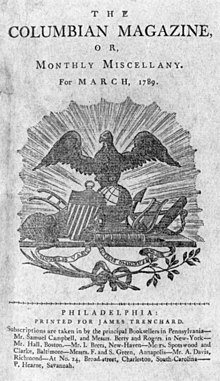
Dr. William Thornton was a British-American physician, inventor, painter and architect who designed the United States Capitol. He also served as the first Architect of the Capitol and first Superintendent of the United States Patent Office.

The Gentleman's Magazine was a monthly magazine founded in London, England, by Edward Cave in January 1731. It ran uninterrupted for almost 200 years, until 1922. It was the first to use the term magazine for a periodical. Samuel Johnson's first regular employment as a writer was with The Gentleman's Magazine.

Stevens Thomson Mason was a Colonel in the Continental Army during the Revolutionary War, a member of the Virginia state legislature and a Republican U.S. Senator from Virginia (1794–1803).

Mathew Carey was an Irish-born American publisher and economist who lived and worked in Philadelphia, Pennsylvania. He was the father of economist Henry Charles Carey.

Russell Sturgis was a noted Boston merchant in the China trade.
American Museum may refer to

Columbia Rediviva was a privately owned ship under the command of John Kendrick, along with Captain Robert Gray, best known for going to the Pacific Northwest for the maritime fur trade. "Rediviva" was added to her name upon a rebuilding in 1787. Since Columbia was privately owned, she did not carry the prefix designation "USS".
Gerrardus Wynkoop was a member of the Pennsylvania House of Representatives from Bucks County and served as speaker of the House in 1793.

The European Magazine was a monthly magazine published in London. Eighty-nine semi-annual volumes were published from 1782 until 1826. It was launched as the European Magazine, and London Review in January 1782, promising to offer "the Literature, History, Politics, Arts, Manners, and Amusements of the Age." It was in direct competition with The Gentleman's Magazine, and in 1826 was absorbed into the Monthly Magazine.

Abel Bowen (1790-1850) was an engraver, publisher, and author in early 19th-century Boston, Massachusetts.
The American Museum was a monthly American literary magazine published by Mathew Carey in the late-18th century. The American Museum "shares with the Columbian Magazine the honor of being the first successful American magazine."
John Dabney (1752–1819) was a postmaster, publisher, and bookseller in Salem, Massachusetts, in the late 18th and early 19th centuries. He was born in Boston in 1752 to Charles Dabney and Elizabeth Gardner. With Thomas C. Cushing, John Dabney published the Salem Mercury newspaper, 1787-1789. In 1790 he married Abigail Mason Peale (1767-1834). Beginning around 1790 he ran the "Salem Book-Store" which offered books for sale or short-term rental; customers included William Bentley. Dabney also served as Salem postmaster ca.1792-1815. He belonged to the North Church in Salem and the Essex Lodge of the Freemasons. Dabney sold the contents of his shop at auction in 1818. He died in 1819.

William Paulet Carey was an Irish art critic and publicist, known also as an engraver and dealer. He spent half a century promoting British art, most of his writings being distributed gratuitously.

There are 20 known contemporary accounts of the First Fleet made by people sailing in the fleet, including journals and letters. The eleven ships of the fleet, carrying over 1,000 convicts, soldiers and seamen, left England on 13 May 1787 and arrived in Botany Bay between 18 and 20 January 1788 before relocating to Port Jackson to establish the first European settlement in Australia, a penal colony which became Sydney. At least 12 people on the fleet kept a journal of their experiences, some of which were later published, while others wrote letters home during the voyage or soon after their arrival in Australia. These personal accounts of the voyage were made by people including surgeons, officers, soldiers, ordinary seamen, and Captain Arthur Phillip, who commanded the expedition. Only one known account, that of James Martin, was by a transported convict. Their journals document the day-to-day experiences of those in the fleet, and record significant events including the first contact between the European settlers and the Aboriginal people of the area. In 2009, the manuscript journals were included in The Australian Memory of the World Register, a regional register associated with the UNESCO international Memory of the World programme.
This article provides a list of notable depictions of the Great Seal of the United States, excluding the official dies.

Reception to Washington on April 21, 1789, at Trenton on his way to New York to Assume the Duties of the Presidency of the United States is a large-scale oil painting completed in 1930 by American artist N. C. Wyeth of president-elect George Washington at his reception in Trenton, New Jersey during his journey to the 1789 inauguration in New York City. The mural was commissioned by the First Mechanics National Bank of Trenton, now part of Wells Fargo. It has been on display in the lobby of Thomas Edison State University since 2013. Wells Fargo donated the painting to the university in 2019, the most expensive gift ever given to the university.
James Trenchard (1747–?) was an American artist, printmaker, and engraver. He was born in Penns Neck, Salem County, New Jersey and by 1777 had moved to Philadelphia to work as an engraver. He was an illustrator for the Columbian Magazine and was its publisher from 1789 to 1790. In 1793 he emigrated to England.











